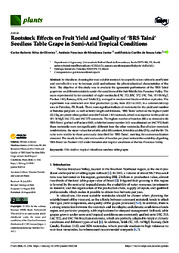Rootstock effects on fruit yield and quality of BRS Tainá seedless table grape in Semi-Arid tropical conditions.
Rootstock effects on fruit yield and quality of BRS Tainá seedless table grape in Semi-Arid tropical conditions.
Author(s): OLIVEIRA, C. R. S. de; MENDONCA JUNIOR, A. F. de; LEAO, P. C. de S.
Summary: In viticulture, choosing the most suitable rootstock for a specific scion cultivar is an efficient and cost-effective way to increase yield and enhance the physicochemical characteristics of the fruit. The objective of this study was to evaluate the agronomic performance of the ‘BRS Tainá’ grapevine on different rootstocks under the conditions of the Sub-Middle São Francisco Valley. The main experimental factor consisted of eight rootstocks (IAC 313, IAC 572, IAC 766, 101-14 MgT, Paulsen 1103, Ramsey, SO4, and Teleki 5C), arranged in randomized blocks with four replicates. The experiment was conducted over four production cycles, from 2021 to 2023, in a commercial crop area in Petrolina, PE, Brazil. There were significant effects of rootstocks for the yield and number of bunches per plant, as well as berry length and firmness. ‘BRS Tainá’ achieved the highest yield (22.2 kg per plant) when grafted onto the Paulsen 1103 rootstock, which was superior to the yield on 101-14 MgT, IAC 313, and IAC 572 rootstocks. The highest number of bunches (88) was obtained with ‘BR Tainá’ grafted on Paulsen 1103, while the lowest number (63) was obtained on IAC 572; both these rootstocks were not significantly different from the other rootstocks. For all scion–rootstock combinations, the mean values for soluble solid (SS) content, titratable acidity (TA), and the SS/TA ratio were similar to those previously described for ‘BRS Tainá’, meeting the commercialization standard. The results for the yield and number of bunches per plant indicate the suitability of grafting ‘BRS Tainá’ on Paulsen 1103 under the semi-arid tropical conditions of the São Francisco Valley
Publication year: 2024
Types of publication: Journal article
Unit: Embrapa Semi-arid Region
Observation
Some of Embrapa's publications are published as ePub files. To read them, use or download one of the following free software options to your computer or mobile device. Android: Google Play Books; IOS: iBooks; Windows and Linux: Calibre.
Access other publications
Access the Agricultural Research Database (BDPA) to consult Embrapa's full library collection and records.
Visit Embrapa Bookstore to purchase books and other publications sold by Embrapa.

